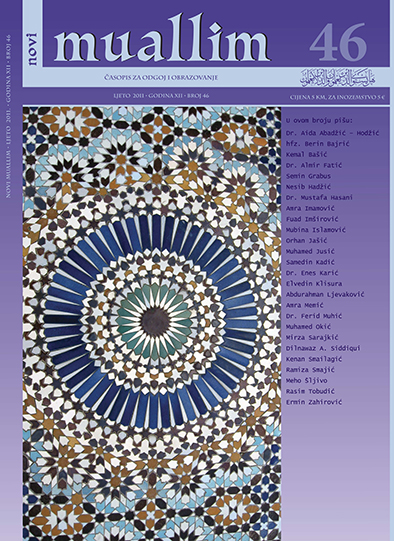KULTURA ODIJEVANJA U BiH NA PRIJELAZU IZ 19. U 20. STOLJEĆE: ULOGA I ZNAČAJ ILUSTRACIJA I PRILOGA U ČASOPISU „NADA“ (1895-1903) U SUSRETU DVA KULTURNA KRUGA
DOI:
https://doi.org/10.26340/muallim.v12i46.668Sažetak
Na prijelazu iz 19. u 20. stoljeće u Bosni i Hercegovini desio se karakterističan i jedinstven susret i ispreplitanje kulturnih krugova alaturca i alafranga. Ovaj zanimljiv i slojevit fenomen, koji je nastao uslijed specifičnih povijesnih okolnosti na ovim prostorima i smjene stare (osmanske) i dolaska nove (austrougarske) uprave, ostavio je karakterističan trag u arhitekturi, urbanizmu, dizajnu, umjetničkom obrtu i načinu odijevanja toga vremena. Strani putopisci, arhitekti i slikari Zemaljske vlade koji su boravili u Bosni i Hercegovini pokazivali su veliki interes za ovaj osobiti aspekt bh. kulture, koji se ogledao kako u sadržajima značajnih razmjera, poput dekoracije bosanskih paviljona na velikim svjetskim izložbama (Budimpešta, 1896; Bruxelles, 1897; Beč, 1898; Paris, 1900), tako i u svakodnevnom životu, načinu odijevanja i novoj kulturi provođenja slobodnog vremena. Spomenuta pojava tumačila se na različite načine, otkrivajući, istovremeno, svoje složeno socio-ekonomsko, političko i kulturno zaleđe - od 'orijentalizirajućih' viđenja Bosne i njenog stanovništva do pokušaja obuhvatnijeg razumijevanja autohtonih vrijednosti i oblikovnih potencijala tradicije. Poseban značaj u bilježenju i praćenju ovih pojava imali su slikovni i tekstualni prilozi objavljivani u časopisu za pouku, zabavu i umjetnost „Nada“, koji je, kao ilustrirana književna revija, izlazio u periodu od 1895. do 1903. godine, u izdanju Zemaljske vlade u Sarajevu i čiji je prvi urednik bio Kosta Hörmann. Tekstualni i likovni prilozi u časopisu „Nada“ pružaju zanimljiv, značajan i dosada potpuno neistražen izvor za cjelovitije zacrtavanje problemskog okvira složenog socio-ekonomskog, političkog i kulturnog fenomena susreta krugova alaturca i alafranga, a koji se u predmetnom razdoblju ogledao i u brojnim polemikama vođenim u periodici, osobito o promjenama u načinu odijevanja, a koje (polemike) danas, u novim političkim i integracijskim procesima, zadobivaju nove i dalekosežnije dimenzije.
Downloads
Objavljeno
How to Cite
Broj časopisa
Rubrika
License
Naknada:
a. Časopis ne naplaćuje naknadu za obradu članaka (APC) i naknadu za podnošenje članaka.
Autori koji objavljuju u ovom časopisu pristaju na sljedeće uvijete:
- Autori zadržavaju autorska prava i pružaju časopisu pravo prvog objavljivanja, pri čemu će rad jednu godinu po objavljivanju biti podložan licenci Creative Commons imenovanje koja omogućuje drugima da dijele rad uz uvijet navođenja autorstva i izvornog objavljivanja u ovom časopisu.
- Autori mogu izraditi zasebne, ugovorne aranžmane za ne-ekskluzivnu distribuciju rada objavljenog u časopisu (npr. postavljanje u institucionalni repozitorij ili objavljivanje u knjizi), uz navođenje da je rad izvorno objavljen u ovom časopisu.


